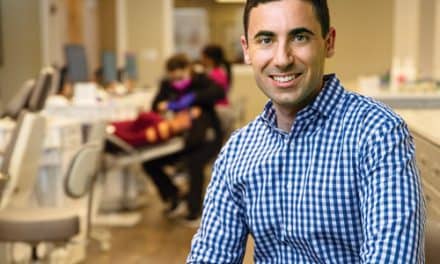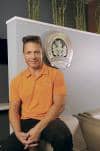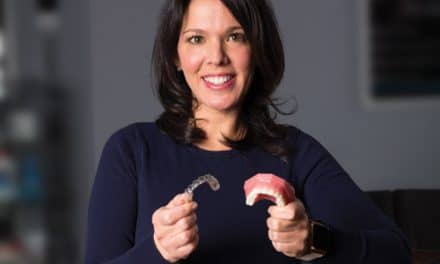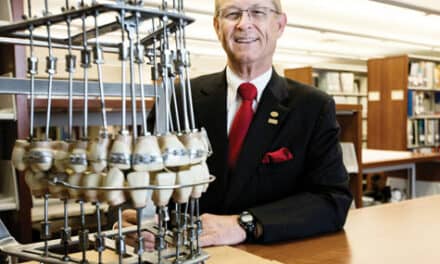by Rich Smith
Maj David P. Lee, DMD, MS, reveals the ups and downs of life as an Air Force orthodontist
 |
The orthodontic practice of Maj David P. Lee, DMD, MS, is climbing high, straight into the wild blue yonder—or at least many of his patients are. They, like Lee, serve in the United States Air Force. Lee’s operation is strictly ground-based, currently located at Eglin Air Force Base in Florida. But with the background roar of jet engines a feature of life at Eglin, Lee’s office sounds as if it could be at home among the clouds.
Lee began Air Force active duty as a commissioned officer in 1997 after graduating from dental school at the University of Pennsylvania, Philadelphia. Now holding the rank of major, Lee has been chief of the 96th Dental Squadron’s Orthodontics Element since landing at Eglin in mid-2006. His main duty is “to teach Advanced Education in General Dentistry (AEGD) residents the principles and techniques that will benefit or support their interdisciplinary and general dentistry treatment,” he says, adding that he also tries to “treat as many Air Force patients as possible to enhance their lives, maintain his skills, and, often, to provide surgical orthodontic patients to the oral surgeons to help maintain their clinical skills.” What’s more, Lee is the officer in charge of the squadron’s dental records (which obliges him to randomly sample the charts once per month to make sure treatment is properly documented and that patients are treated appropriately). He is also the squadron’s process-improvement officer.
PRACTICE PROFILE
Name: Maj David P. Lee, DMD, MS
Location: Eglin Air Force Base, Florida
Owner: United States Air Force
Specialty: Orthodontics, orthognathic treatment
Years in practice: 9
Patients per day: 15–20
Starts per year: 110
Days worked per week: 5
Office square footage: 300
Lee came to Eglin by way of Ramstein Air Force Base in Germany, where he began working as staff orthodontist in 2003. His Air Force practice started in 1997, with a 1-year AEGD residency at Langley Air Force Base in Virginia, after which he served as a general dentist, officer in charge of aerospace dentistry and forensic dentistry, and head of the Red Cross volunteer program at McGuire Air Force Base in New Jersey.
Not Kid’s Stuff
All of Lee’s cases at Eglin involve treatment of men and women in uniform. No kids. Air Force rules require family members of personnel stationed in the continental United States to seek dental care from civilian dentists.
However, back when Lee was at Ramstein in Germany, kids were a big part of his practice. “Regulations encourage on-base treatment of children who live with their parents while their parents are assigned to overseas bases,” he says. “The Air Force recognizes that there are things braces can ideally accomplish while the patient is in childhood, and by providing orthodontics services to them on-base it makes it easier for families overseas to access the quality of care that would be available to them from civilian practitioners stateside.”
Lee reports that demand for braces among adults at Eglin exceeds the capacity of his practice. Consequently, he finds himself in the unenviable position of having to turn away some who request treatment. The good news is that the Air Force has supplied Lee with selection criteria that make the triage process less daunting and sorrowful.
“Most of the patients I end up treating at Eglin present with mutilated dentitions and/or require orthognathic surgery,” he explains. “Typically, they will be missing some teeth and have experienced sufficient drift to prevent the restorative dentist from properly placing a crown or fixed partial denture. I’m often called on to first properly set up the teeth to enable other aspects of dentistry.”
Practicing in the Air Force is in many ways similar to practicing in the civilian world, Lee assures. The most pronounced difference is that all of his work takes place under a chain of command.
 |
“Every base has a base commander who oversees the operation of everything on that base,” Lee says. “Below the base commander is a medical group commander who is responsible for everything dealing with health: physicians, imaging, immunizations, and dental. All things related to dental are the responsibility of a commander of the dental squadron. This officer’s job is to set dental practice policy and make sure that the work of the dentists is performed in accordance with those policies.
“Although each base is responsible for its own dental operations, they all are harmonized by Air Force-wide consultants who make sure every base’s units play from the same sheet of music, so to speak.” That might sound restrictive, but, “What’s nice about that is the dental operations are all going to be pretty much the same wherever you go,” he says. This makes it easy for a clinician to jump right in and almost immediately be up to speed at whatever new base he draws as his latest assignment. “It’s pretty much the same job,” Lee says, “Only the locations change.”
Daily Duties
Chain of command not withstanding, each orthodontist in the Air Force enjoys significant autonomy with regard to clinical decision-making.
“It’s not a situation where we have to send the patient’s treatment plan in triplicate to the higher-ups for authorization before we can proceed,” Lee clarifies. “There are general practice guidelines we must follow in creating our treatment plans. But they are not so detailed that we have no room for professional discretion and interpretation. When I look at a patient, I’m allowed for the most part to treat as I determine best.”
Lee sees 15 to 20 patients per day, spending the rest of his time on his teaching duties. He handles about 110 starts per year, and keeps hours that by and large parallel those of his civilian counterparts.
“My day in the clinic starts at 7 in the morning and ends at 4 in the afternoon, and I maintain that schedule Monday through Friday,” he says. (Come the weekend, Lee indulges inrecreational pursuits such as mountain biking, running, hiking, skiing, and swimming. He also is a travel enthusiast, an avid reader, and confesses a fondness for the game of golf. Wife Angeline Dy, DPM, shares most of Lee’s interests.)
A nice thing about having a military practice, Lee says, is that it eases his conscience when he wants to take a vacation or extended time away from the office. Lee is eligible for 30 days of out-of-area leave each year, and when he uses those days, he does so without worrying about his practice suffering a loss of income during that period. Says Lee, “I’m not the one who writes the checks and pays the bills.” That would be the job of his Uncle Sam.
On the Move
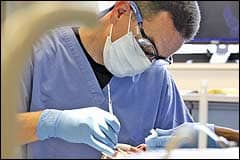 |
| Lee treats his patients with the help of only one assistant. |
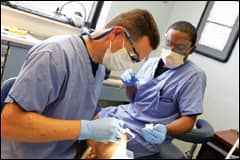 |
Even so, military practice does present challenges. For example, practitioner and patient alike can be transferred from one base to the next, sometimes with scant advance notice due to mission or deployment needs. Because of this, some orthodontists find they cannot develop the kinds of long-term relationships with patients that otherwise would be possible. “The problem is you develop a treatment plan with the kind of mechanics you like, then you receive a transfer order and have to hand the case over to a new orthodontist who may not be as enthusiastic about your choice of mechanics,” Lee offers. “Occasionally, kids already in treatment will move to overseas locations. It’s very helpful if these patients come with good records and a completed AAO transfer form. This enables the orthodontist to more easily continue their care.”
Orthodontists, he adds, are transferred to fill vacancies created by other practitioners who retire, leave the Air Force, become reassigned to other locations, or advance to higher-level responsibilities. “The average time a dentist is assigned to a base is at least 3 years,” Lee estimates.
Lee also knows that some of the personnel he works on and sends away with new, beautiful smiles will end up in combat, where the potential exists to undo all that transformative effort—and a whole lot worse. “All you can do,” he says, “is hope and pray for the best, hope and pray that those who are assigned to combat duty return home safely.” Lee reports that he infrequently finds himself called upon to participate in the oral restoration of wounded or injured flyers and field support personnel.
Another hurdle military orthodontists face involves support staff. Unlike their civilian counterparts, orthodontists like Lee (who is aided by one lone technician) have little or no say in who becomes an Air Force dental assistant.
By and large, the chairside team is picked at random. If the orthodontist lands a good team, credit the luck of the draw. Otherwise, “They must work together to develop the most efficient and functional team,” Lee explains. “Within our clinic setting, we have some flexibility in who works with whom,” Lee says. “We try to get a feel for which assistants like to be involved in what types of cases, and which ones have the extra specialized training in different areas of dentistry. We then match assistants with the case types that make the most sense.”
Facilities designated for orthodontic and dental practice vary in size and shape from one base to the next. At Eglin, Lee’s two-chair, open-bay operatory measures just under 300 square feet. A computer is stationed alongside each chair, giving him access to the schedule, patient records, and now also digital radiography. “What I’ve got in terms of equipment and materials is comparable to what you’d find in any civilian practice,” he insists. “We don’t have the most expensive things, but neither do we have the least expensive. We use good, solid technology at every level.”
Keep ‘Em Flying
Technology is practically Lee’s middle name. A whiz at high school math and science, Lee, who hails from North Bergen, NJ, was urged by a high school guidance counselor to wrap his future around engineering. Accordingly, he went to Stevens Institute of Technology in Hoboken, NJ, where he studied electrical engineering and graduated cum laude in 1989. From there, he went to work at AT&T, where he spent 4 years as a systems manager in New York and Atlanta. He was a go-to guy for East Coast customers with business information processing needs; and he was responsible for acquiring, implementing, and troubleshooting new hardware and software on their behalf.
“It was a good job, but I wanted more human interaction than I was getting from sitting in front of a computer all day,” says Lee, who eventually was spurred to think hard about the kind of career he really wanted to have. As it happened, both his sister and her husband were dentists. Lee arranged to spend time with them in their office to get a sense of what they did and to understand how they derived satisfaction from it. It did not take long for Lee to conclude that dentistry was a profession he ought to join. “There was a lot of hands-on activity in my sister’s and brother-in-law’s practice, and that was something I craved. Plus, they looked like they were having a lot of fun as dentists,” he says.
In 1993, Lee entered the University of Pennsylvania, Philadelphia, School of Dental Medicine. During his junior year, the Air Force awarded him a health professions scholarship. Later this year, Lee (who has now repaid with service the Air Force’s financial contributions to his education) will decide whether to make a career of the Air Force or return to civilian life.
“I have no regrets about the Air Force,” he says. “The Air Force has been very good to me. I’ve met lots of great people and been to places I could only have dreamed of were it not for the Air Force. The big thing I’m concerned about is the way my fairly frequent relocations impact my wife’s ability to find and keep employment as a podiatrist. That’s a quality-of-life issue for us.”
On the other side of the equation, turning in his uniform would mean that Lee would have to give up what he enjoys most about Air Force life: the camaraderie of the dozen or so other dentists and dental specialists assigned to his squadron.
“Every case I have is multidisciplinary,” he explains. “And if I have questions about a case, I have only to walk down the corridor to talk with colleagues in those other disciplines. I’ve got easy, friendly access to oral surgeons, periodontists, and others. There’s almost never a need to call first and schedule time to talk. To my thinking, there is no doubt that being able to practice side-by-side in this fashion with so many other specialists has made me a better practitioner of my own specialty.”
Rich Smith is a contributing writer for Orthodontic Products. For more information, please contact
A Man of Many Medals
When Maj David P. Lee, DMD, MS, puts on his dress uniform, a number of ribbons and medals adorn the area near his heart. Among them are the Meritorious Service Medal, the Air Force Commendation Medal, and the Air Force Outstanding Unit Award (with four oak-leaf clusters). He also was named the Air Mobility Command Dental Officer of the Year for 1999.
 |
Earning these and other honors is not what inspired him to join the Air Force in 1997. It was a recruitment presentation that featured a talk by an Air Force dentist. “She made practice in a military setting seem extremely interesting,” Lee remembers.
Before agreeing to sign up, Lee was taken on a tour of nearby McGuire Air Force Base’s dental clinic. He recalls being impressed by the collegiality and upbeat demeanor of the dentists he met. That was a big plus in Lee’s view. So was Uncle Sam’s offer to pay for the remainder of his dental training in exchange for a pledge that he serve at least 3 years in the Air Force.
Although he was officially in the Air Force beginning with his junior year at the University of Pennsylvania in Philadelphia, Lee did not begin wearing the uniform full-time until graduating in 1997. After 4 years of general dentistry experience, Lee was selected for orthodontic training; he started in 2001 at Temple University School of Dentistry in Philadelphia.
“I enjoyed all aspects of dentistry, but I really wanted to specialize in orthodontics,” he says. “I liked the fact that there was more opportunity to get to know the patients—you see them more frequently as compared to dental patients who come in mainly because of pain, so there’s more continuity to the relationship. I also liked the mechanics involved in orthodontics—originally being an engineer, that really appealed to me.”
—RS


